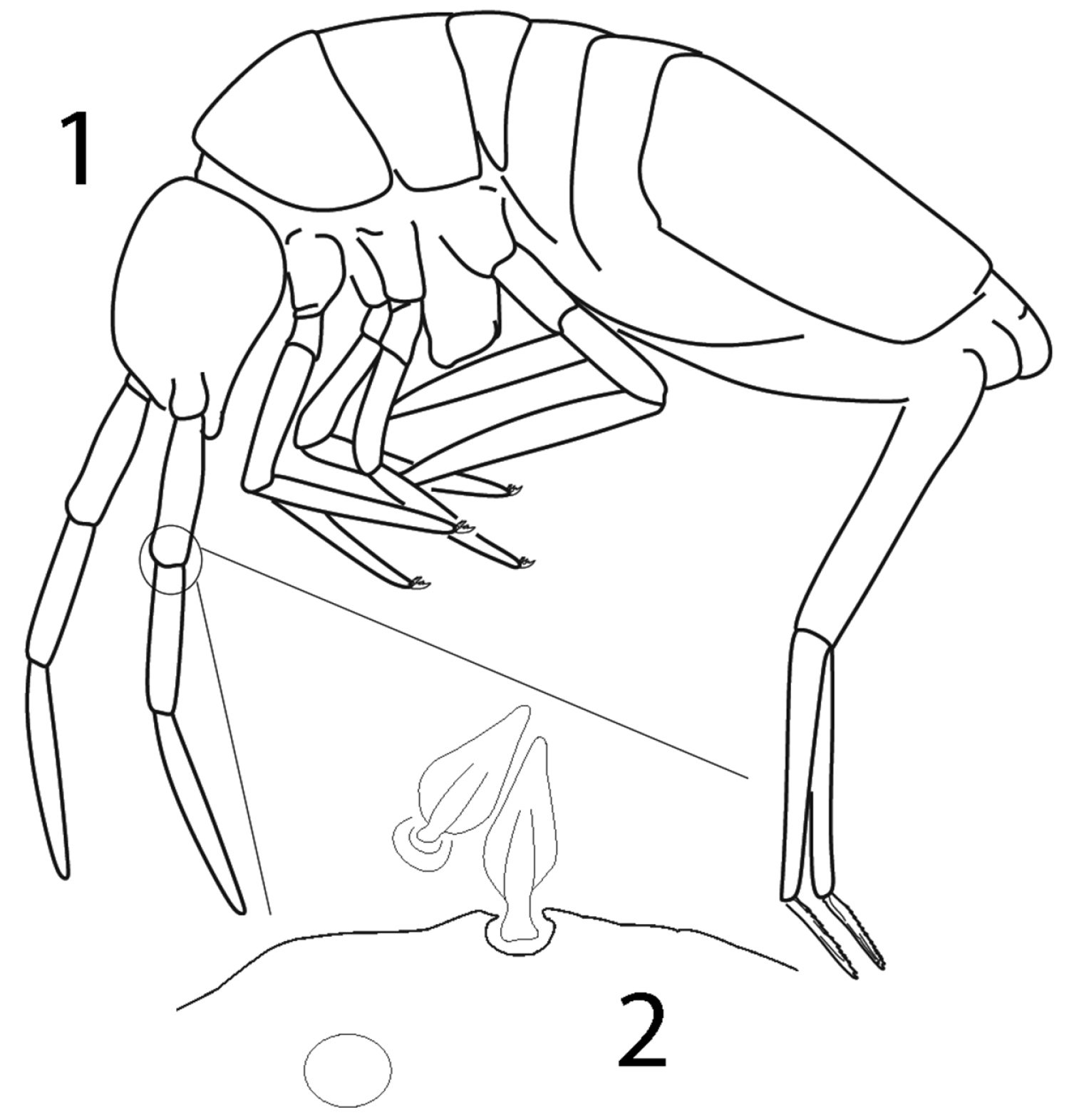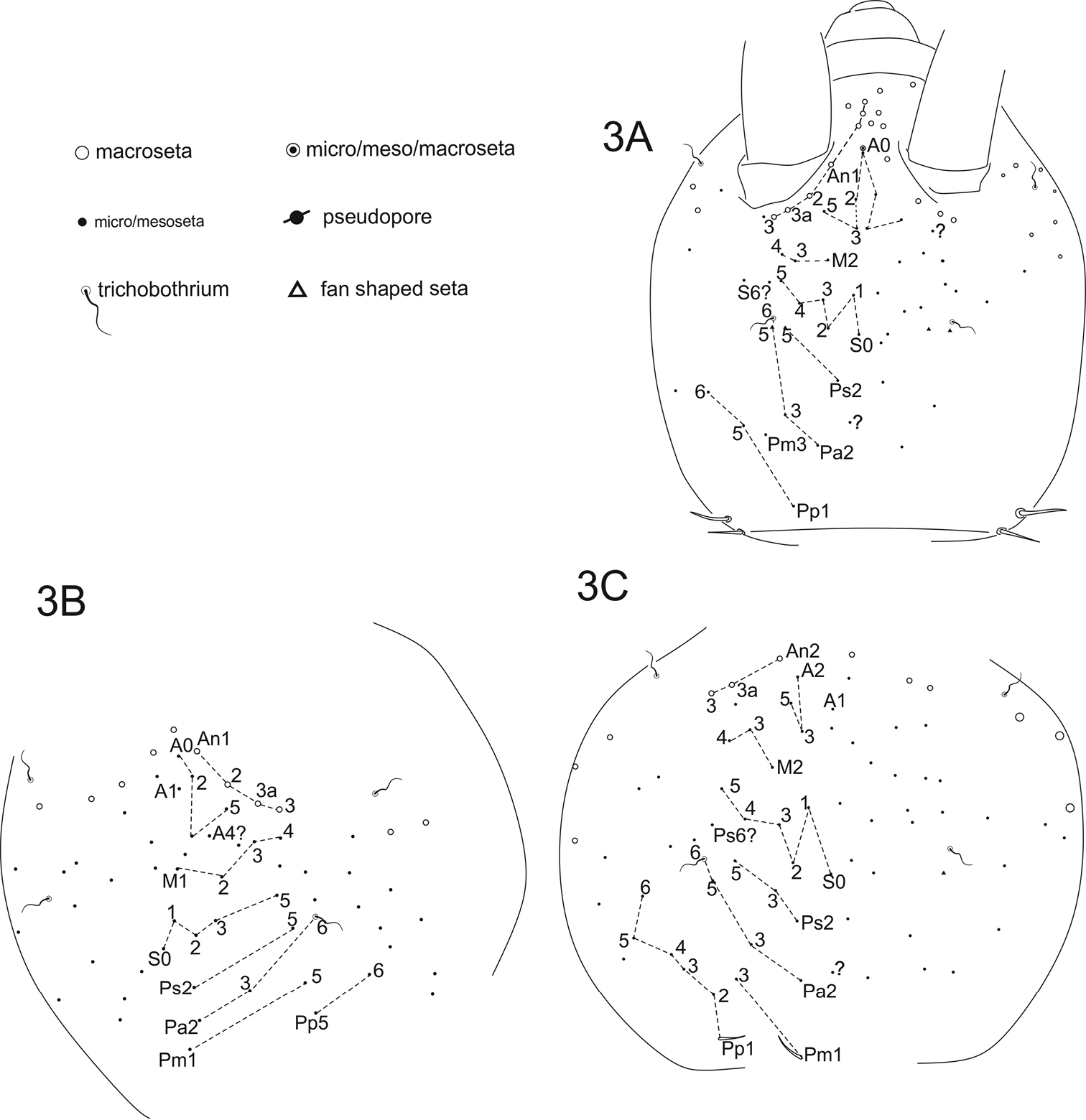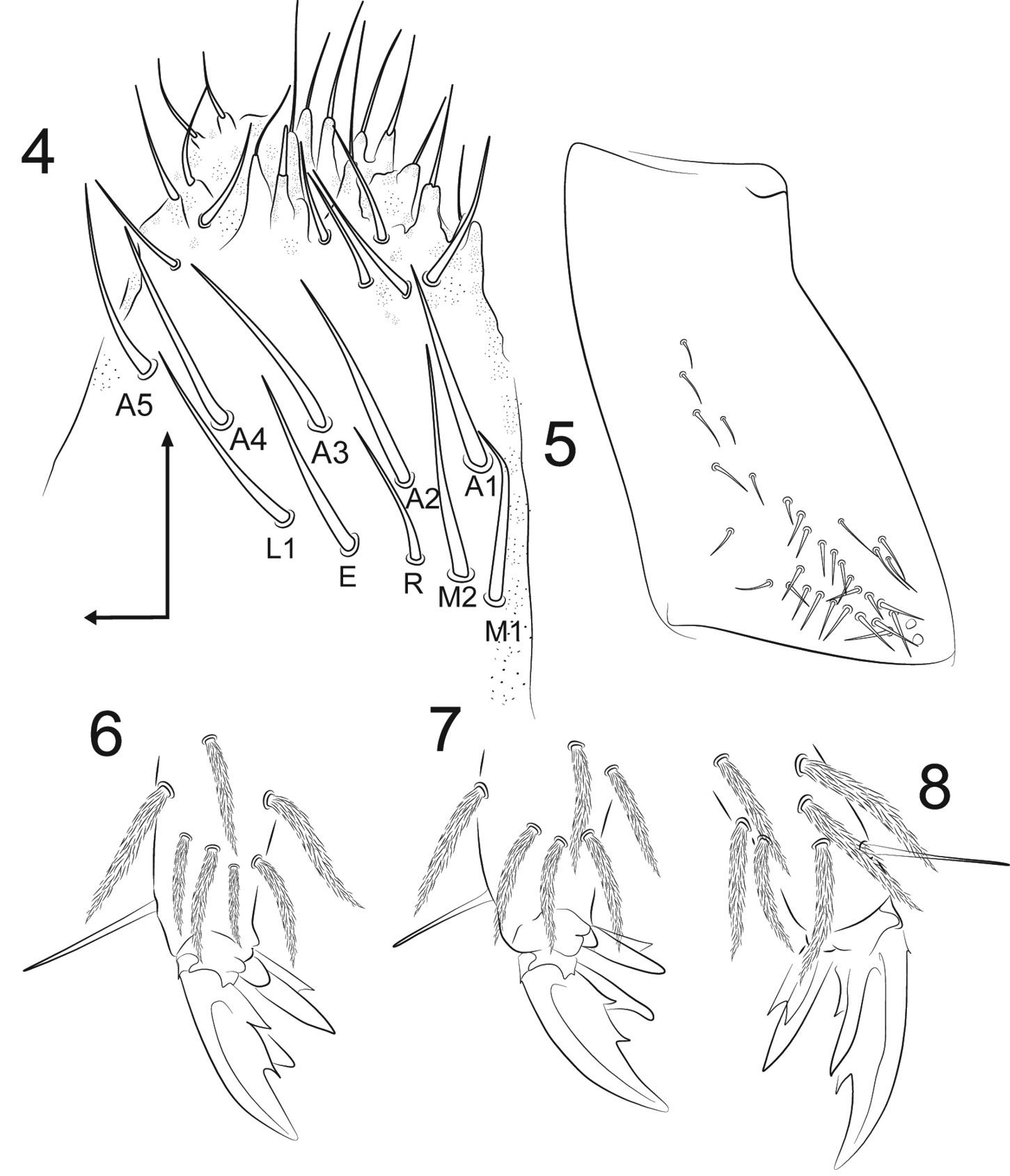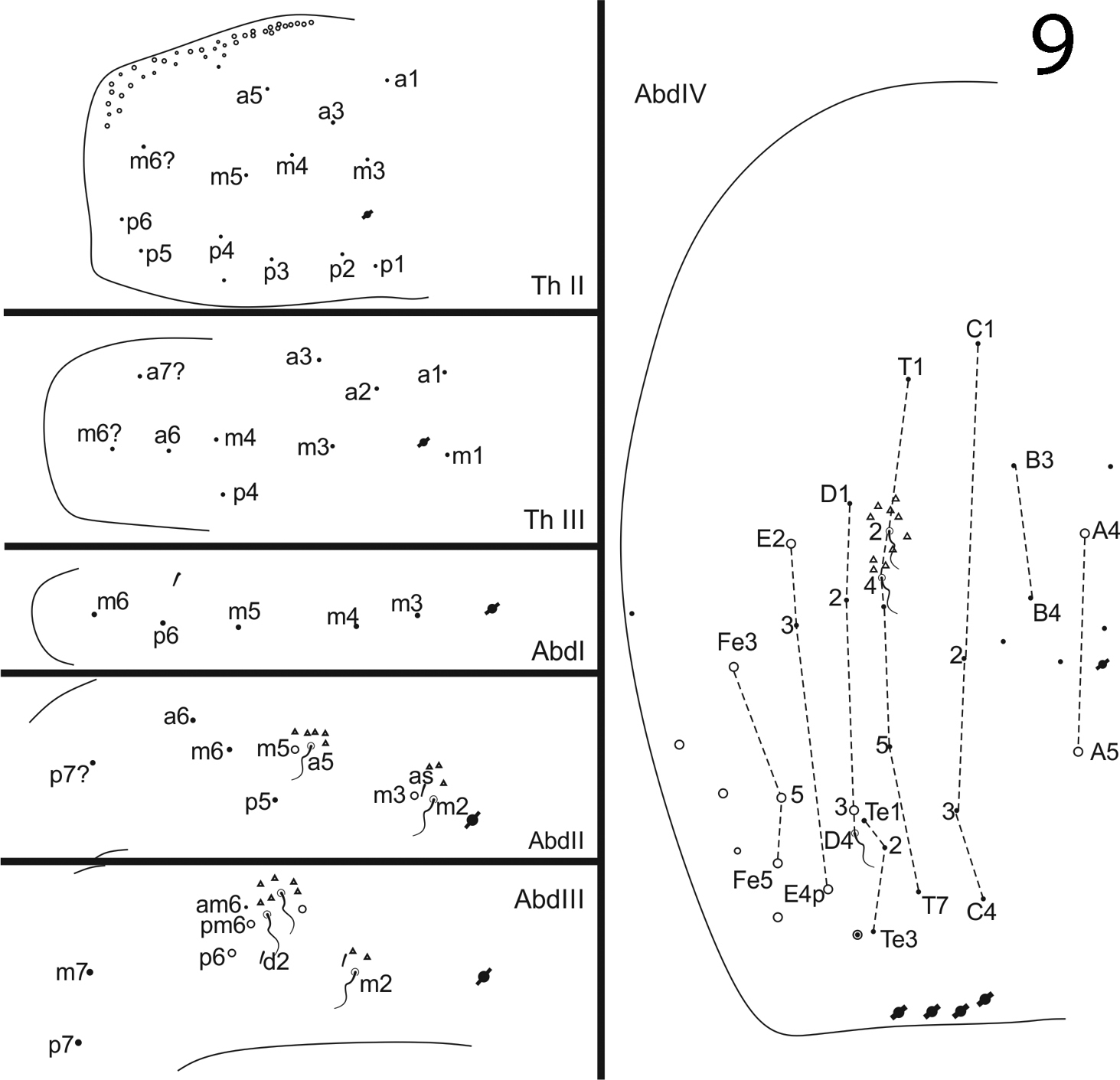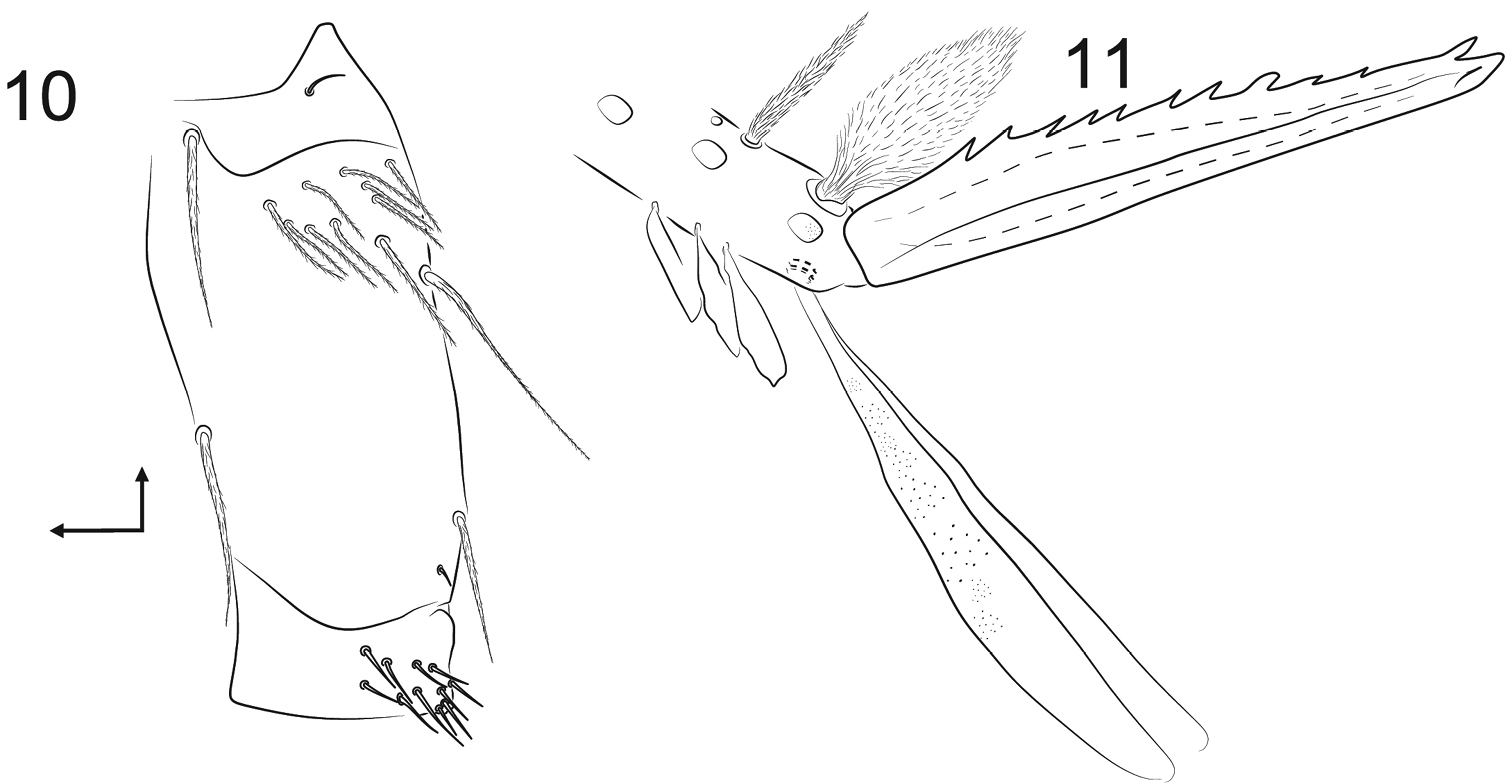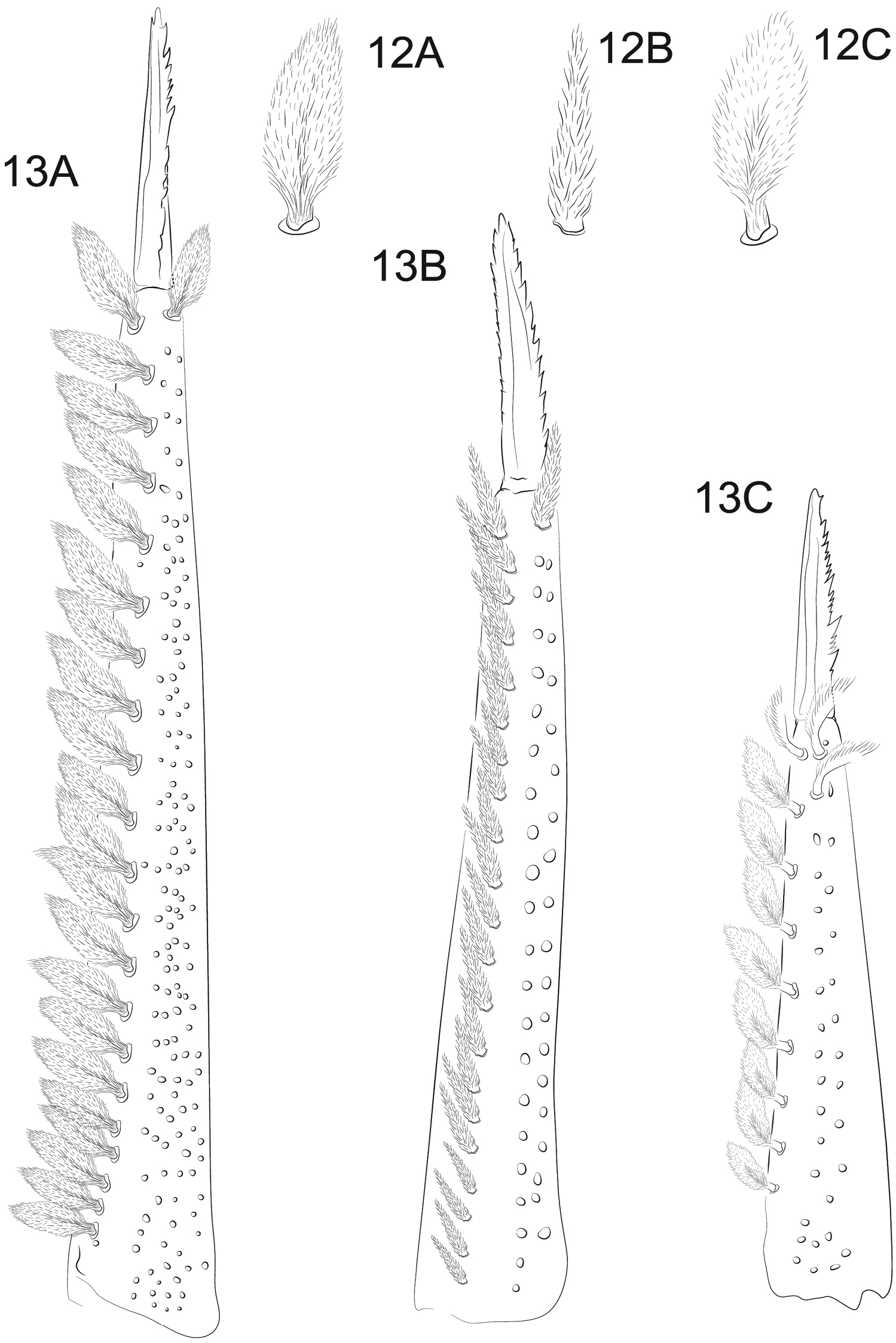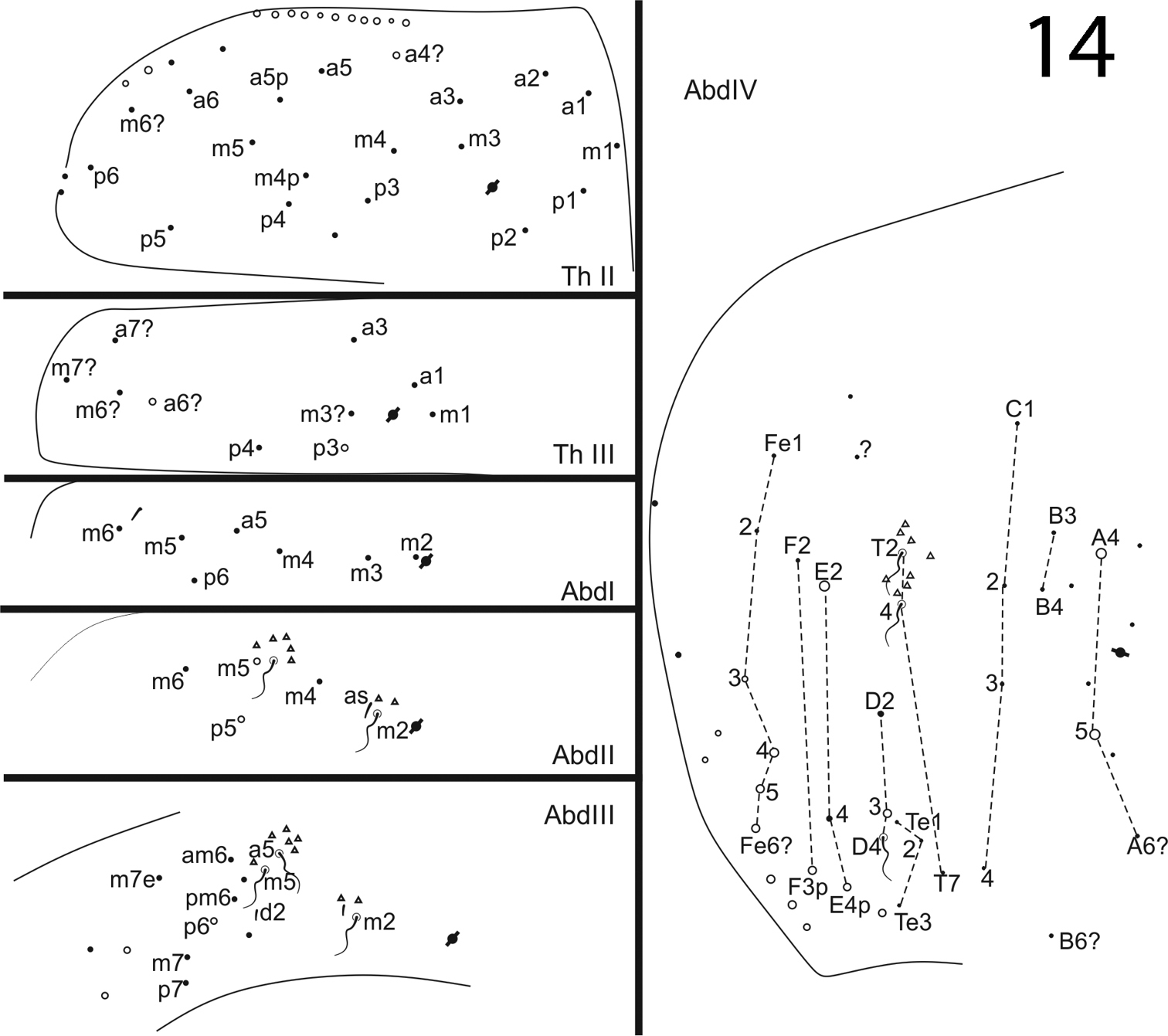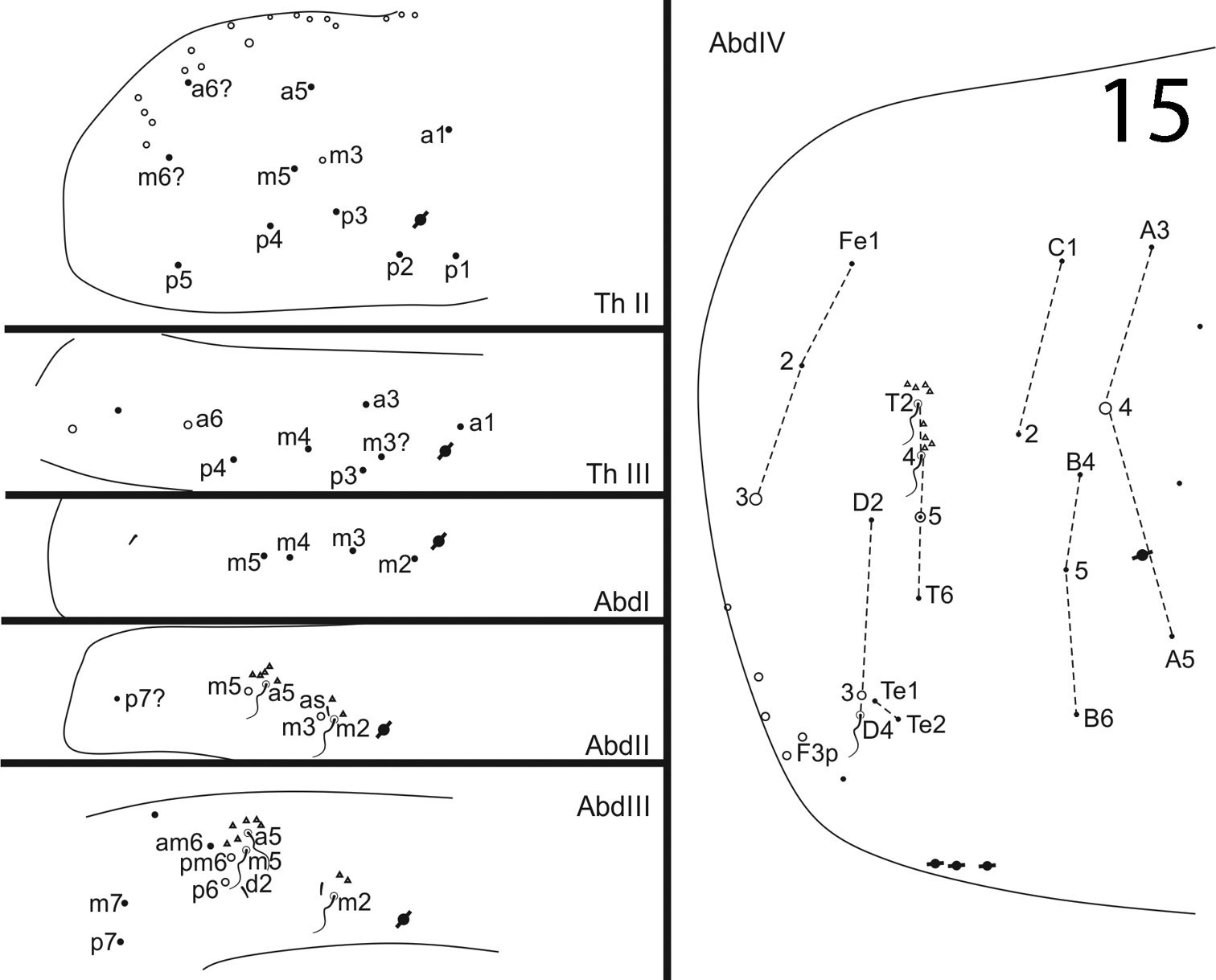






Citation: Zeppelini D, da Silva DD, Palacios-Vargas JG (2014) A new species of Troglobius (Collembola, Paronellidae, Cyphoderinae) from a Brazilian iron cave. Subterranean Biology 14: 1–14. doi: 10.3897/subtbiol.14.7355
The genus Troglobius (Collembola: Paronellidae: Cyphoderinae) is known only from the Southern Hemisphere, the two species found so far were described from caves in Madagascar and Brazil. In this paper we describe a new Brazilian species and complement the descriptions of the previously known species. The new species is a troglomorph and was collected in a single cave, in iron formations in the state of Minas Gerais. Brazil. The original diagnosis of the genus is supplemented with new characters based on observations of the new species.
Cave Fauna, Iron Ore, Iron Caves, Taxonomy, Southern Hemisphere
The genus Troglobius Palacios-Vargas & Wilson, 1990 comprises two species, both from caves in Southern Hemisphere, the type species Troglobius coprophagus from Madagascar and Troglobius brasiliensis Palacios-Vargas & Zeppelini, 1995 from Brazil. The genus belongs to the Collembola family Paronellidae Börner, 1913 (Entomobryomorpha) and has been assigned to the subfamily Paronellinae since its original description and in recent contributions (
The distribution of the genus in Brazil ranges from caves in the Amazon rain forest in Northern region, to caves in the subtropical Atlantic Forest domains in Southeastern region. Sampling in caves in iron formations are bringing new records to the distribution of the fauna in Brazilian iron caves, and important information on the generic characters of the genus. Unpublished material is still waiting for formal descriptions suggesting that the diversity of the genus in Brazil is likely to be much greater than the single described species.
The gap of information about cave fauna and cave Collembola from Africa make for the moment difficult to propose biogeographic hypothesis to explain the origin and distribution of the genus. Considering that the two new species (Troglobius coprophagus and Troglobius brasiliensis) are confined to caves (as it is known up to date) and isolated from one another with disjoint distribution, we can suppose that this is a relict genus with Gondwanian distribution. However, the answer will depend on the distribution and better knowledge of the African species.
This study presents a new species of Troglobius from iron-caves, which is described and compared with the two already described species. Furthermore, complementary morphological data is given to the description of Troglobius coprophagus and Troglobius brasiliensis. A new diagnosis is proposed to the genus, the taxonomy was revised and comparative analysis of the morphology of the species, with the diagnosis of subfamilies in Paronellidae resulted in new taxonomic arrangement for the genus in the Cyphoderinae subfamily.
Specimens were collected with pitfall traps, fixed in ethanol 70% and slide mounted in Hoyer’ solution. Two paratypes were dissected. Head and body chaetotaxic systems followed
Taxonomic position:
Family Paronellidae Börner, 1913
Subfamily Cyphoderinae Börner, 1913 (sensu
Troglobius coprophagus Palacios-Vargas & Wilson, 1990
Habitus as Entomobryomorpha, eyeless, without pigment. Body with ciliated chaetae and hyaline ovoid scales. Mesothorax and metathorax not humped or bent. Ant. IV not subdivided. Labial chaetotaxy with chaetae: M1, M2, R, E and L1 present, L2 absent. Head bearing two pairs of trichobothria. Mucro elongate, four times as long, or more, than its greatest width, with many serrations along one or both dorsal lamellae. Dens without spines, anterior side covered with scales. A couple of large scale, about the same size as mucro, present on apex of anterior surface of dens. Posterior side of dens with, at least, three rows of chaetae and scales. Some (or most) scales, or thick chaetae, of internal row deeply fringed. In other rows only some distal chaetae modified. Unguis and unguiculus with winged teeth.
The original description places the genus in the family Paronellidae Börner, 1913.
Separation between Paronellinae and Cyphoderinae is based on the presence of fringed dental scales in the latter and their absence in the former. All cyphoderines are eyeless, whereas the majority of paronellines have eyes. In addition, all cyphoderines have scales, whereas many paronellines lack these scales.
The morphology of the dental scales, the absence of eyes, the shape of mucro and the presence of large scales at the tip of dens, about the same size as mucro, indicate that the genus Troglobius belongs to the subfamily Cyphoderinae (with 128 species distributed among 13 genera of blind Collembola) instead of Paronellinae (with 384 species in 27 genera) as proposed by
In the new proposed diagnosis for the genus, we conclude that the labial chaeta “R” is present, normal shaped, and variable in size, while chaeta L2 is always absent. An additional lateroventral trichobothria, close to the basis of antennae is present in each side of head, this feature is also seen in Cyphoderus, another genus of Cyphoderinae. The genus Troglobius can be differentiated from other Cyphoderinae by the shape of the mucro, which has, at least one lamella serrated.
Brazil, Minas Gerais, Itabirito, Várzea do Lopes. Cave VL29/30, 20°20'05"S, 43°56'18"W. Aphotic zone on water film over the substrate and organic matter, 8 individuals collected.
Holotype. Slide mounted in Hoyer’s solution. Deposited at “Coleção de Referência de Fauna de Solo da Paraíba – Universidade Estadual da Paraíba” (CRFS/UEPB), #2766. Várzea do Lopes, Itabirito, MG, Brazil. Cave VL29/30. 02-06/x/2011. Leg. Speleology team of Carste consultants.
Paratypes. One paratype deposited at Laboratorio de Ecología y Sistemática de Microartrópodos - UNAM (slide #2837 donated from CRFS/UEPB). Várzea do Lopes, Itabitito, MG, Brazil. Cave VL 29/30. Andrade Col. 03-20/XI/2007.
One paratype deposited at Muzeu Nacional – Universidade Federal do Rio de Janeiro - MN/UFRJ (slide #2765 donated from CRFS/UEPB) Várzea do Lopes, Itabitito, MG, Brazil. Cave VL 29/30. 03/IV/2012. Other two paratypes at CRFS/UEPB, under numbers #2838 and 3098, from the same locality as the holotype.
Habitus of entomobryomorphs (Fig. 1). Length (n = 4) 2.3 mm in average (1.9-2.7 mm). Color pearly white. Body with smooth and ciliated chaetae of different sizes, oval scales hyaline, trichobothria long and ciliated.
1 Habitus, Troglobius ferroicus sp. n. 2 Antennal sensilla of apex of Ant. II, same type of sensilla seen on apex of Ant. III. Troglobius ferroicus sp. n.
Ratio head:antenna 1:2.5, ratio antenna:body length 1:1.9. Ant. I-II with scales. Ratio of Ant. I-IV as 1: 2.6; 2.5; 3.7. Apex of Ant. II with three candle-shaped sensilla, two close to each other and a third laterally displaced (Fig. 2). Apical sensory organ of Ant. III with two candle-shaped sensilla, apical guard chaetae thicker than others. Ant. IV undivided, with rows of chaetae and sensilla or finely ciliated microchaetae, without apical bulb.
Eyes and pigment absent, head with two pairs of trichobothria (Fig. 3A), chaetae Ps5 and Pa5 ciliated. Pre-labral and labral chaetae formula 4/5, 5, 4; all chaetae smooth. Labial triangle with anterior row (A1-5) smooth. All labial triangle chaetae smooth, labial seta R well developed, L2 absent (Fig. 4).
Cephalic chaetotaxy A (Troglobius ferroicus sp. n.), B (Troglobius brasiliensis), C (Troglobius coprophagus).
4 Labial triangle, Troglobius ferroicus sp. n. 5 Metatrochanteral organ, Troglobius ferroicus sp. n. 6 Unguis I, Troglobius ferroicus sp. n. 7 Unguis II, Troglobius ferroicus sp. n. 8 Unguis III, Troglobius ferroicus sp. n.
Legs with ciliated setae. Coxa of leg I with one chaeta. Metatrochanteral organ with 21 chaetae forming a “V” and 13 additional short chaetae (Fig. 5). Tenent hairs acuminate, shorter than ventral lamella of unguis (Fig. 6-8); ratio unguis: tenent hair = 1: 0.65. All unguis with two inner basal winged teeth of different sizes; one median inner tooth and one very small tooth at the base of the outer lamella. All unguiculi with well-developed outer lamella and normal sized inner lamella (Figs 6–8).
Abd II with two trichobothria, Abd III-IV with three trichobothria each; Abd. IV with 4+4 lenticular organs on posterior margin (Fig. 9). Posterior surface of ventral tube with 2 long macrochaetae, scales on proximal end, 10 proximal pairs of ciliated chaetae and 11 distal pairs of small smooth chaetae; anterior face with only 2 pairs of ciliated macrochaeta (Fig. 10).
Body chaetotaxy Troglobius ferroicus sp. n.
10 Ventral tube chaetotaxy, lateral view, Troglobius ferroicus sp. n. 11 Distal end of dens and mucro, Troglobius ferroicus sp. n.
Furcula with scales and ciliated chaetae; mucro, dens and manubrium ratio 1.0:3.8;4.2. The distal end of dens with a pair of large scales, about the same size of mucro (Fig. 11). Dens without spines, normal scales on anterior side, internal row of posterior face with 21 fringed scales (Fig. 12A), median row with one fringed scale (Fig. 13A). Other rows with finely ciliated chaetae in irregular pattern. Mucro elongated, bearing 10–15 teeth on outer lamella, inner lamella smooth with one tooth at the tip.
12 Dental chaetae A (Troglobius ferroicus sp. n.), B (Troglobius brasiliensis), C (Troglobius coprophagus) 13 Dens and mucro A (Troglobius ferroicus sp. n.), B (Troglobius brasiliensis), C (Troglobius coprophagus).
The name of the new species Troglobius ferroicus sp. n. comes from Latin ferrum (iron) and Greek oikos (house). This makes allusion to the iron caves where the new species was found.
Good’s biogeographic zone 27, northeastern and central Brazil (
Troglobius ferroicus sp. n. is found in small (less than 100 m deep) iron-caves, dwelling on water film over the rocks and organic debris in the aphotic zone. The species was found in a single cave, and it is likely to be a troglobite which lives in the in the Mesovoid Shallow Substratum (MSS) (
This cave is placed in a mining area with iron ores, which represents a putative threat to the species if the cave and surrounding environments, including the MSS, are not preserved. The species was included in the recent evaluation of the Brazilian Fauna Red List, and must be published in the next issue of the Brazilian Red List as Critically endangered (CR).
Troglobius ferroicus sp. n. is the largest species in the genus, adults are 2.3 mm long in average (2-2.8 mm), while other species are about 1.5 mm long (Table 1). It has the longest antennae and ratio of head:antennae (Table 1). Ungual internal unpaired teeth are lacking in Troglobius coprophagus, there are two teeth in Troglobius brasiliensis and a single tooth in Troglobius ferroicus sp. n. Mucronal serration is different in Troglobius brasiliensis, where both edges are serrated, in Troglobius coprophagus and Troglobius ferroicus sp. n. the inner edge is smooth. One important diagnostic feature to differentiate the species is the relative size of mucro and dens, the ratio mucro/dens in Troglobius ferroicus sp. n. is 1:4.0, in Troglobius brasiliensis is 1:3.0 and Troglobius coprophagus 1:2.5. Number and shape of the dental scales can, also, easily differentiate the species (Figs 12–13). Chaeta m2 on Abd. I is lacking in Troglobius ferroicus sp. n., and present in the other two species, and chaeta T1 on Abd. IV is present in Troglobius ferroicus sp. n., but absent in the other two species.
Comparative measurements and ratios of the three species of the genus Troglobius.
| Size | Ratio head/Ant | Ratio body/Ant | Ratio Ant segments | Ungual teeth | Ratio mucro/dens;man | |
|---|---|---|---|---|---|---|
| Troglobius brasiliensis | 1.5 | 1:1.8 | 1:1.7 | 1:2.5; 2.5; 3.0 | 2 | 1:3.5;4.2 |
| Troglobius coprophagus | 1.4 | 1:1.7 | 1:2.3 | 1:1.2; 5.6; 13.1 | 0 | 1:3.4;5.7 |
| Troglobius ferroicus sp.n. | 2.3 | 1:2.5 | 1:1.9 | 1:2.6; 2.5; 3.7 | 1 | 1:3.8;4.2 |
Finally, Troglobius coprophagus was found in La grotte d’Andrafiabe (25°C and 100% of humidity) in Ankarana, which is a small limestome massif in the extreme North of Madagascar. Troglobius brasiliensis was found in Cave Limoeiro at Pará, North Brazil and Gruta dos Paiva at Sao Paulo, Southeastern Brazil, both in limestone massifs. The new species Troglobius ferroicus sp. n. was found in one iron cave in the state of Minas Gerais, with very different climate and environmental conditions.
Head chaetotaxy as Fig. 3B. Apex of Ant. II and Ant. III with small candle shaped sensillae. Dens anterior side with hyaline scales; posterior side with three rows of modified thick chaetae (Fig. 12B), internal row with 21 fringed chaetae, the distal chaeta of median row is also heavily fringed, external row with about 20 barbulate chaetae (Fig. 13B). A large chaeta, about as long as mucro, is present at the distal tip of the dens. Mucro with 12–14 teeth on inner lamella and 14 in outer lamella. Body chaetotaxy as in Fig. 14.
Body chaetotaxy Troglobius brasiliensis.
Paratype, Brasil, Sao Paulo, Iporanga. Cave Gruta dos Paiva. col. Trajano, E. 20/II/1989.
It is important to mention that the species Troglobius brasiliensis was described from specimens collected in caves in Northern Brazil. The type locality of this species is Cave Limoeiro (7-X-1988, Brasil, Pará, Medicilandia, Caverna Limoeiro. Col. E. Trajano), a small municipality in Para state in the Amazonic Region. A single specimen, assigned as paratype, comes from a different locality in Southeastern Brazil, far away from the type locality. This is the specimen studied here. Some differences were observed in specimens from both localities, as mentioned in the original description (
Head chaetotaxy as in Fig. 3C. Abd IV with 3+3 lenticular organs posterior margin. Dens anterior side with hyaline scales; three rows of modified thick fringed scales (Fig. 12C) present on posterior side, internal row with 9–10 fringed scales, median row with 2 distal fringed scales, other median chaetae thick and ciliated, external row with about 11 barbulate chaetae (Fig. 13C). A large chaetae, about as long as mucro is present at the distal tip of the dens. Mucro with about 19 teeth on outer lamella, inner lamella smooth. Body chaetotaxy as in Fig. 15.
Body chaetotaxy Troglobius coprophagus.
One of the species author, Wilson, was not able to maintain specimens alive once they were taken outside the cave, which indicates that they are very sensitive to temperature changes (
Two paratypes, Madagascar, Grote d’Andrafiabe. 08/IX/1986.
The senior author was granted by CNPq #301803/2012-9. The specimens were collected by the speleology team of Carste consultants. Roniere A. Brito (Universidade Estadual da Paríba) helped in slide mountings. Blanca Mejía Recamier (Universidad Nacional Autónoma de México) dissected the specimens. Felipe Soto-Adames revised the English version of the manuscript.
